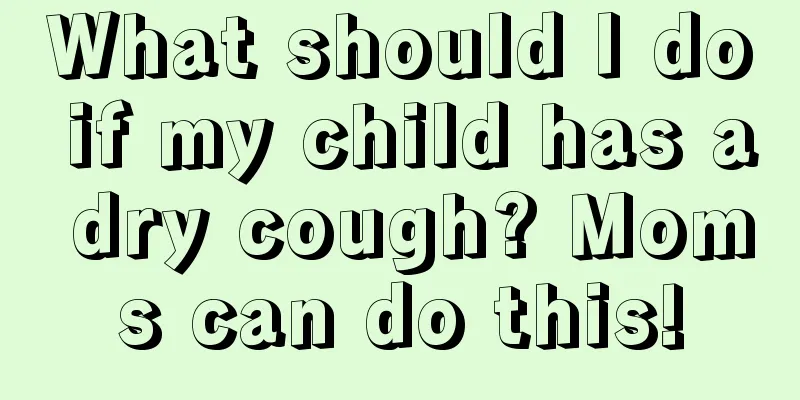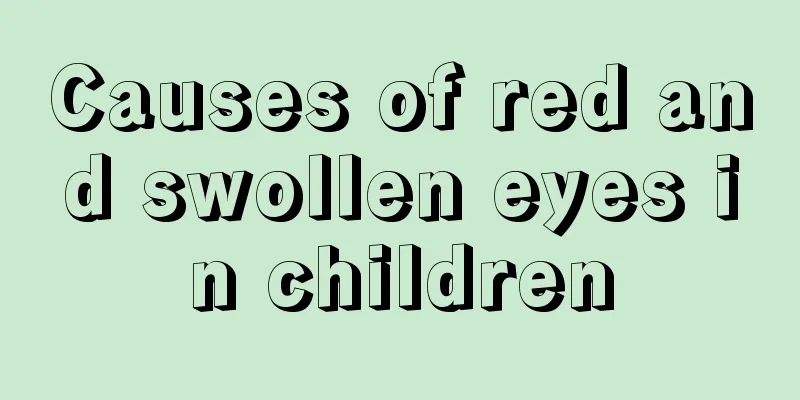About the dietary treatment of wind-heat cold in children

|
Children are very susceptible to wind-heat colds because their body functions have not yet been fully established and their immunity is relatively low. So how much do you know about the dietary treatments for wind-heat colds in children? We can be our own children's doctors, and these are relatively simple things we can do to help our children. Here are some dietary treatments for wind-heat cold in children! 1. Main symptoms and causes: Fear of wind, sweating or no sweating, headache, conjunctival congestion, nasal congestion and purulent nasal discharge, sneezing and coughing, thick white or yellow sputum, thirst and sore throat, red or swollen throat, red tongue, and thin white or thin yellow tongue coating. Wind-cold colds are more common in winter and spring and are caused by external wind and cold. 2. Diet therapy: 1. Appropriate amount of raw olives. For those with red, swollen and painful throats, chewing raw olives can help clear away heat and relieve throat pain. 2. Star fruit. Wash and eat raw carambola, which is effective for treating wind-heat cold, cough and sore throat. 3. Crush 15 grams of mung beans and 10 grams of tea leaves. Boil a bowl of water and cook for another ten minutes, remove the residue, add appropriate amount of sugar and take it all at once. 4. 4 black plums and 90 grams of brown sugar. Boil a bowl of water and take it in two doses. 5. Pear 1) Eating fresh pears raw in moderation is suitable for treating wind-heat colds. 2) Pear porridge: Chop 3 duck pears, boil them in water for half an hour, drain the juice and cook porridge with appropriate amount of rice, and eat while hot. This is especially suitable for children with wind-heat cold and cough. 6. Add 5 sections of scallion, 3 slices of ginger, and 30 grams of brown sugar to hot porridge or hot soup and boil for 10 minutes. Drink it while it is hot and cover yourself with a blanket to sweat. It is not advisable to eat too much cold food: such as persimmons, crabs, chicken, duck, pork, bananas, watermelons, etc. 7. Three root soup: 3 Chinese cabbage roots, 7 green onion roots, and 15 grams of reed root, decocted in water and taken orally. Take once a day for 2-3 days. It is pungent and cool and can relieve exterior symptoms, and is suitable for children with wind-heat colds. Chinese cabbage tastes sweet and is mild and cold in nature. It has the effects of clearing away heat and detoxifying, and relieving cough and reducing phlegm. Reed root is sweet and cold in nature. It can clear away heat, promote body fluid, relieve restlessness and stop vomiting. Secondly, if you have loss of appetite, fear of cold, and runny nose due to cold in summer, you can try using 15 grams each of astragalus and jujube, and 5 slices of ginger, boil them together over high heat, then simmer over low heat for 1 hour, and drink the soup after it cools down a little. Drink it twice a day for 3 consecutive days to cure wind-heat cold. 8. People who suffer from wind-heat colds are usually a little afraid of cold, so in order to maintain body temperature and force sweat out of the body, you can wash and cut 5-7 green onions into grains, peel and wash 4 slices of ginger, wash 60 grams of glutinous rice, and add an appropriate amount of rice vinegar. Put the prepared ingredients (except the scallion whites) into the pot, then add appropriate amount of water and cook into porridge, finally add the scallion whites and seasonings, add rice vinegar and stir well. I believe that through the above introduction, more parents and friends can learn about the many methods that can help children. What are the dietary therapy methods that can be used when children suffer from wind-heat colds? We will have medicine to find and we don’t have to worry so much. So how much do you understand the suggestions and advice we gave above? I hope your child can recover soon! |
<<: What should I do if my two-month-old baby's jaundice has not subsided?
>>: Common physiological phenomena in infants
Recommend
What to do if your child has a lot of yellow phlegm
The yellow sputum in children may be caused by in...
Sequelae of elbow fracture in children
Children's elbow fractures are mainly caused ...
What should I do if my child has a muscle strain?
Many children do not exercise regularly, and they...
Pelvic effusion in little girl
We know that there are two types of pelvic effusi...
Why does a one-month-old baby fart smell bad?
What worries people the most now is the newborn b...
What is the reason for a two-year-old baby to have a fever and convulsions?
Families are most worried about their children ha...
Can babies eat ginseng?
Ginseng is a well-known health-care herb that is ...
How to deal with baby's fever and convulsions
We know a lot about baby's diseases, but we d...
What to do if your child is picky about eating
Children's picky eating and anorexia is a pro...
There is a small hole on the baby's ear
A small hole on the baby's ear is a congenita...
What to do if baby has eczema at the corners of mouth
Children are the apple of their parents' eyes...
What's the matter with blood in baby's stool?
If there is blood in the baby's stool, it may...
What to do if your child is fat?
Nowadays, living conditions are better, and many ...
What causes squint in children?
Children always have problems when they are young...
Diagnosis and treatment of fetal hydrocele
Fetal hydrocele refers to the accumulation of exc...









